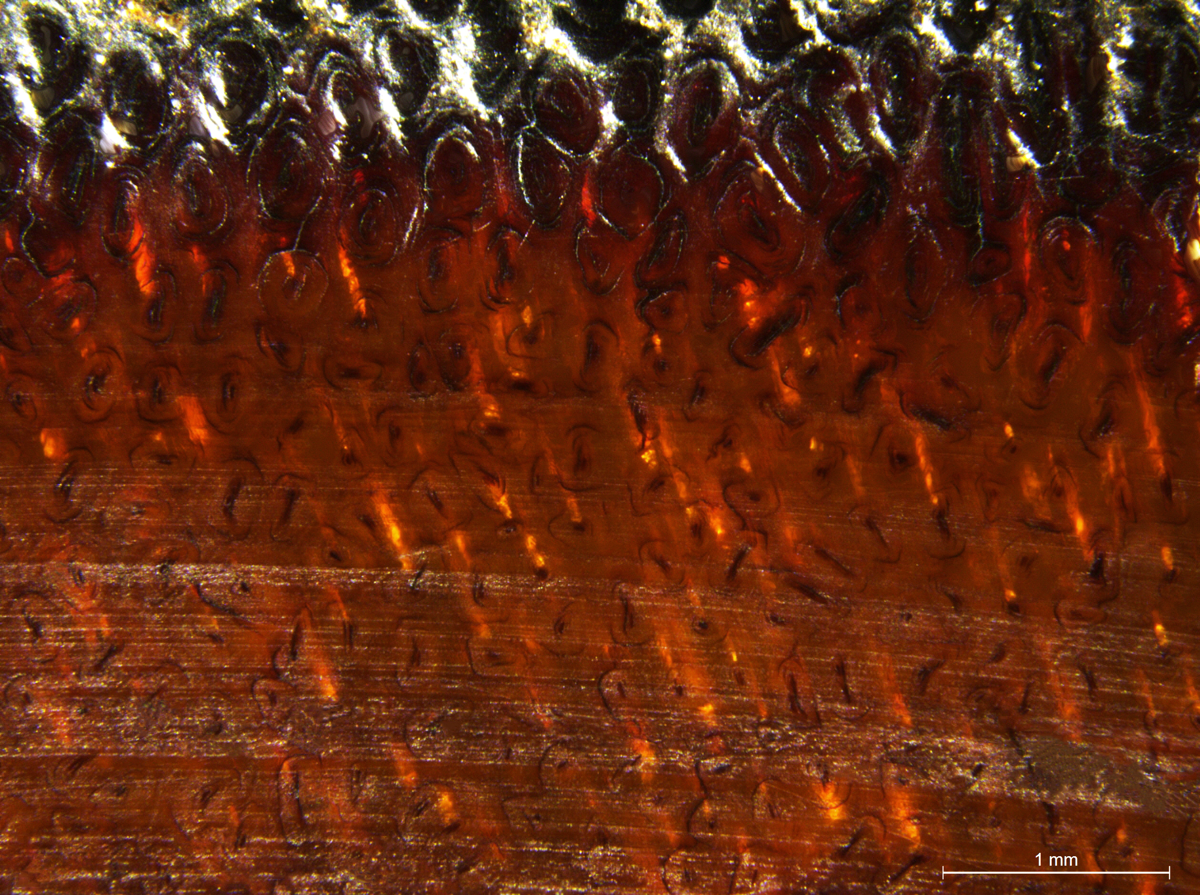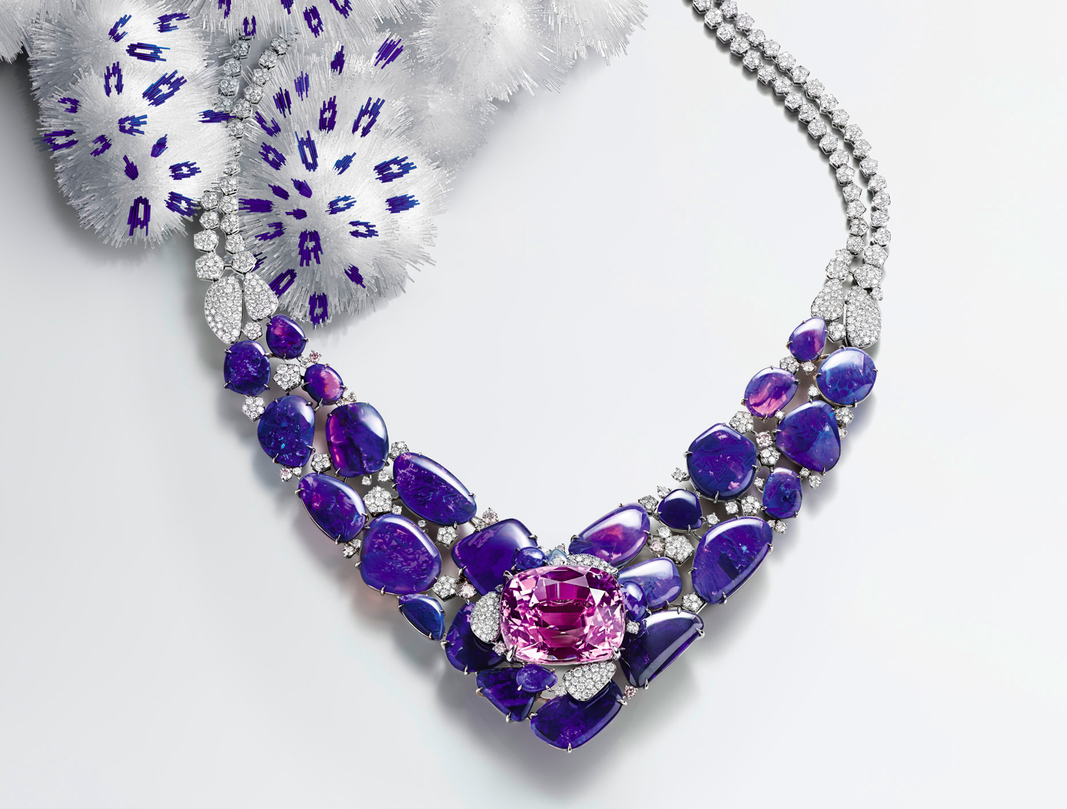By Emilie Disner, Candice Caplan, Franck Notari
GGTL-Laboratories Switzerland- 4bis route des Jeunes, 1227 Les Acacias Geneva, Switzerland
*****
Figure 1: The analysed section. Photo E. Disner.
The GGTL laboratory in Geneva recently received a cup sculpted from an organic brown material. The bowl weighed 251.97 grams, measured ≈ 12.5 / 11.0 / 11.0 cm and was in a leather carrying case (Fig. 1 and Fig. 4).
Figure 2: Abrasion damage on the upper and outer part of the cup, showing the fibrous texture of the material. Photo E. Disner.
At first glance, the object appeared to be made of wood, due to its matte, opaque and fibrous appearance (Fig. 2 and Fig. 3). After careful microscopic examination, the cup turned out to be made of rhinoceros horn.
The article by Guindeuil (2014) allows us to draw a parallel between this object and other vessels made for the consumption of alcohol in Christian Ethiopia. Indeed, this antique piece has been dated to the second half of the 19th century and is thought to have originated in Ethiopia. This type of cup, shaped like a truncated cone, is called a wança (used as a beer glass) and its case is called a käzäna. Its base might suggest a chalice but not its overall shape.
The GGTL laboratory has some experience in certifying ancient Chinese cups made from rhinoceros horn, but this is the first time we have received a cup made from this material from this part of the world.
Figure 3: Micrograph of the bottom of the cup showing traces left by the manufacturing process. Photo E. Disner.

Figure 4 (a, b, c): Leather protective and transport case. The lid is held in place by four leather straps passing underneath two braided ornaments. The straps are lowered to close the case. Photo E. Disner.
The lid of the case shows traces of abrasion that coincide with the same damage as that observed on the upper part of the bowl (Fig. 2 and Fig. 5). Careful examination of these marks showed that they were clear evidence of wood-boring or scavenging insect attacks. Considering the position of the damage, the attack obviously occurred when the cup was in its case. The insects did extensive damage to the leather and, fortunately, to a lesser extent to the cup.
Figure 5: The damage to the case lid coincides with the damage to the cup Photo E. Disner.
Preamble
The position of GGTL Laboratories regarding the rhino horn trade is very clear, we strongly condemn it.
Considering our last exchanges with the competent authorities of the Swiss territory (veterinary services, customs etc.), we have taken the decision to no longer consider the certification of rhinoceros horn, including ancient objects (knowing that it is sometimes difficult to objectively establish whether it is or not) in spite of the legal framework filed by the CITES(https://cites.org/fra/search/site/rhinoceros).
A- History and tradition
Rhinos have been hunted by humans since late antiquity until today, mainly in Asia and especially for their horns. The horns are highly prized and reputed to have mythical, unproven virtues, and are therefore used for traditional medicinal purposes. They are also used as simple ornamental objects.
Originally, rhinoceros skin was used to make breastplates and shields, while the horns were carved into ritual libation cups with prophylactic properties. It was believed that when poison was poured into the cup, the horn material would begin to shake, warning of danger. From then on, horns were considered a poison detector and were carved into intricate and refined cups, making them a choice gift for dignitaries in ancient China. The carving highlights the transparency of this orange-brown material, as we can see in this libation cup decorated with flowers (lotus), a recurring motif for this type of object (Fig. 6). It is said that any good collector of the sixteenth and seventeenth centuries with a cabinet of curiosities had to have one of these carved horns.
Figure 6: Chinese libation cup, private collection. Photo C. Caplan.
Furthermore, the sexual behaviour of the rhinoceros has been detrimental to its own interests. Unlike many species, courtship can last for an hour, several times a day. Such vigour coupled with the suggested shape is probably the source of the aphrodisiac reputation attributed to the horn. Indeed, the consumption of ground horn as an infusion is believed to have powerful aphrodisiac effects and medicinal properties against cancer, for example. To date, horns have no scientifically proven medicinal properties. Yet these legends are the main cause of the slaughter of rhinos through poaching. Because of the traditions, the Far East is still the largest market, with an ever present craze for rhino horns.
Already in Roman times, rhinos had become rare in Asia. China, through India, brought horns from Africa, which were in the hands of the Roman trade. In the 15th century, thirty years before the Portuguese expansion, the Muslim admiral Zheng He launched a Chinese fleet of 63 ships that explored the world through the Indian Ocean from 1405 to 1433, in seven expeditions. China then bought horns directly from Africa. The trade continues to this day.
In Ethiopia, important events in the social life of Christians are accompanied by the consumption of fermented drinks in dedicated cups (see Guindeuil, 2014). As for the cup under examination, the use of rhinoceros horn testifies to the prestige of the owner. Wança cups, intended for drinking beer, were used by all social groups in Ethiopia. In addition to its original use, the wança cup, which was supposed to travel with its owner in a wooden case (käzäna), could also be used as a measuring tool. These cups are usually turned on a lathe, with two to four grooves near the opening and a similar pattern at the base. Most of them are made of ox horn, while the more prestigious ones are made of ivory or rhinoceros horn. The less prestigious ones are made of wood or clay. The quality of the cup is also judged by its size and workmanship.
B- Identification of rhinoceros horn
Rhino horns, worn by both males and females, are not horns in the strict sense of the word because they do not have a bony base like deer horns for example. Nor do they resemble elephant tusks or walrus tusks. Rhino horns consist solely of agglutinated keratin (a fibrillar protein found in hair, hooves and nails). This special structure can be seen under magnification (Fig. 7 and Fig. 8). This compact mass of tightly fused, hard hair is the rhino’s defensive weapon, and serves to ensure its supremacy over a harem as well as over a territory. Unfortunately, the horn is also hard enough to be carved.
Figure 7: Structure of the horn, adapted from Hieronymus, Witmer and Ridgely (2006). Illustration C. Caplan.
Unlike ivory which is hollow, rhino horns are solid. The colour can vary from a dark reddish brown to a light (honey) brown and, in this case, due to environmental conditions and age, dark brown.
The structure of the horn is visible in micrographs of the base of the cut, where it has been polished by use (Fig. 8). The apparent section of the horn shows keratin tubules with darker spots in the centre; these are the medullary cavities. Note the brownish orange colour and transparency that characterise rhinoceros horn.
Plastics are commonly used to imitate rhinoceros horn (usually acetate or polyester, as in tortoise shell), but in this case no internal structure can be seen.
Figure 8: Micrograph of the base of the cup (transmitted and reflected light). The medullary cavity, the canals in the centre of the tubules and the characteristic transparency can be seen. The slightly curved whitish lines are traces made by the lathe that shaped the object. On the upper part, the structure resulting from the agglomeration of the hair is explicit. Micrographs F. Notari.
*****
End of the first part, the continuation in a few days on the site!
















